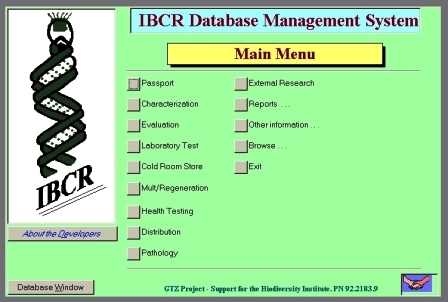The proper documentation of plant genetic diversity is an indispensable part of making diversity useful to farmers, breeders and researchers. Before we can use what we’ve got, we’ve got to know what we have.
Standards, protocols and Descriptors Lists
In order to increase national and international acquisition and exchange of genetic materials, a certain amount of uniformity in data collecting, recording, storage and retrieval is critical. Developing standards for documentation and protocols for exchanging information is essential for ensuring that bridges can be built between myriad information sources. Descriptors Lists are a central part of this process.

Coping with the vast amount of data on Plant species and varieties and making it available requires adequate database design and information management systems. The Institute of Biodiversity Conservation Germplasm Database Management System (EBI DMS) was built more or less taking such standards into consideration. The system stores information on passport data, characterization data, Evaluation data, and gene bank management data.
Passport Data
The documentation of Plant diversity collections begins with recording important data when scientists first collect the plant material. This ‘passport data’ includes basic information on where, when, and what was collected. Descriptors Lists provide a standard language for recording this information.
The passport data of about 60000 accessions is stored on computer databases and incorporated into genebank management systems of the EBI DMS and accessible to users through agreed conditions.
This is particularly important for planning future collecting missions, determining gaps and duplications in collections. This information is also very valuable for crop breeding programmes, afforestation and diversity analysis such as for species distribution maps.
Characterization
Characterization of each sample involves a careful description of the special characteristics that are inherited, easy to score, and expressed consistently in all environments.
Since most of the traits recorded during characterization are those that can be seen, the person responsible for managing the germplasm material is best placed to carry out the work of documenting these characteristics.
Many of the characteristics that are recorded on individual accessions can serve as diagnostic descriptors for the accessions. Such diagnostic characters help genebank curators keep track of an accession and check for the genetic integrity over a number of years of conservation.
Again, descriptors lists are a vital tool for ensuring that those who are documenting the characteristics of conserved species are using the same language and standards.
Evaluation
Evaluation goes deeper than characterization. It may require special biochemical techniques and usually include agronomic performance, yield and biotic and abiotic stresses, such as drought or pest. These traits are important to plant breeders and researchers in crop improvement. Such evaluation may also use DNA-based methods to analyze a plant’s genetic diversity.
The evaluation descriptors, although contributing to some extent to identifying an accession, are more interesting than characterization descriptors because of their value in crop improvement. In general, effective evaluation is possible when there is close institutional and personal interaction between curators and breeders or other crop improvement scientists, and where breeding objectives are reflected in evaluation programmes.
Evaluation is primarily carried out by users, in multidisciplinary teams that include breeders, entomologists, pathologists and agronomists. The potential value of the germplasm depends on the efficiency of the techniques designed to differentiate among accessions. Because the farmers are the ultimate users of the product of any crop improvement programme and possess valuable traditional knowledge, due consideration must be given to involve farmers’ views and expectations at some point during any evaluation programme.
Source: Bioversity International (with minor edits by EBI)
